After a terrible start to the season, where the club languished close to the relegation zone, RSC Anderlecht sacked manager Felice Mazzú, who had just arrived in the summer from Brussels rivals Royale Union Saint-Gilloise.
After a period with an interim manager, Anderlecht looked to England for their next permanent boss.
The club hired Brian Riemer, the assistant to Thomas Frank at Brentford.
Before this job, the Dane had no prior top-level coaching experience, with his only head jobs being for the U19 sides of both Hvidovre IF and Danish giants FC Copenhagen.
In addition, Riemer has been the assistant at the latter and Brentford, helping his compatriot get the club into England’s top tier.
So far, Riemer has had a great start to life in Belgium. Since his arrival, the club has only lost twice in ten matches in the league, and it has advanced to the Last 16 of the UEFA Europa Conference League.
This tactical analysis will
examine some of the tactics the Danish manager has implemented to begin to awakenthis sleeping giant of Belgian football.
Brian Riemer Formations
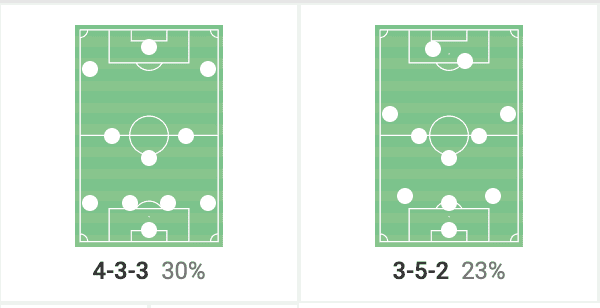
The image above shows the two most used formations for Anderlecht this season, with Riemer implementing the 4-3-3 since his arrival late last year.
When Mazzú was in charge, he opted to set the Belgian side up in a 3-5-2, something that he had used with great success during his time at Union Saint-Gilloise.
However, the personnel did not seem a great fit for this system, with former Manchester City defender Vincent Kompany using a back-four system for much of his previous time in charge.
Once Riemer came in, he opted for a 4-3-3, which has had resounding success, as shown by the recent results of the Belgian giants.
Also, the Dane has made some changes within the starting lineup, with the most notable being the implementation of a new starting goalkeeper as longtime starter Hendrik van Crombrugge was dropped for 20-year-old Dutchman Bart Verbruggen.
All of these things combined have led to a positive impact on Anderlecht’s form this season.
With the switch to a more defensively friendly 4-3-3 formation, the Belgian side has not conceded as many goals at the back this season while also getting some really good results from the attacking side of the game.
Brian Riemer Tactics – Attacking rotations in wide areas
When analysing Brian Riemer’s coaching style at Anderlecht from an attacking perspective, one of the first things that stands out is the use of attacking rotations in the wide areas of the pitch.
These rotations aim to drag the defenders out of their zones, creating space behind the backline.
This then allows the Belgian side to progress the ball vertically by playing long, getting the ball into the attacking area as quickly as possible.
This is not to say Anderlecht are not a possession-based team under Brian Riemer.
In fact, the opposite is actually true.
Under Riemer, Anderlecht averages more possession than their opposition, with them averaging around 56% of the ball per match.
This is a reversion to what they were under Kompany, while they were not as much possession-based under Mazzú.
The following examples will examine these rotations in the wide areas that Anderlecht has been using to good effect recently and how the record champions attack in general under the Danish manager.
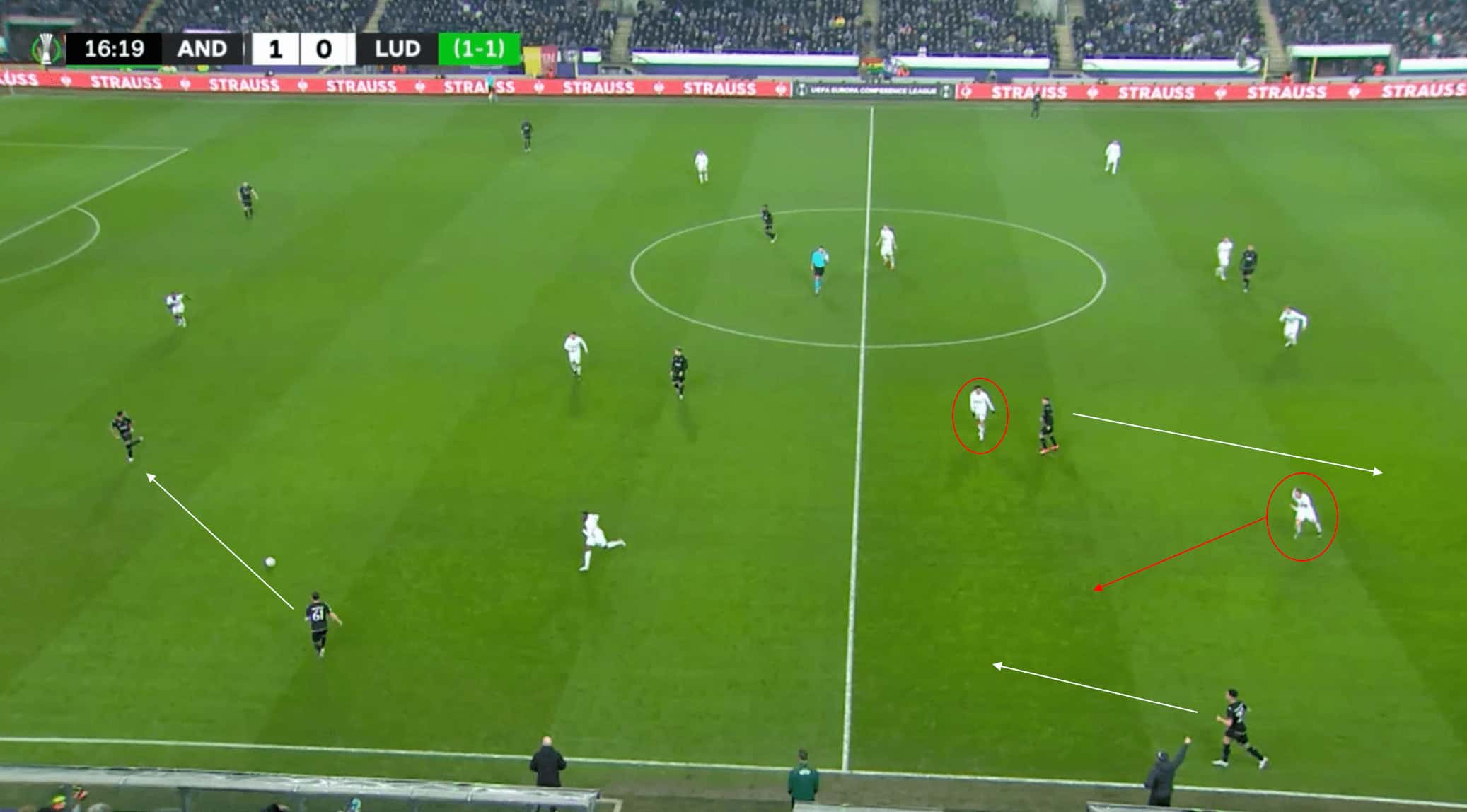
The image above shows one example of the attacking rotations in the wide areas that help to create space for balls to be sent behind the opposition’s defence.
In the phase of play above from Anderlecht’s recent Europa Conference League match against Ludogorets Razgrad, Anderlecht are in possession, with the ball in possession of the fullback on the near side.
In the attacking half, Anderlecht has essentially isolated the opposition fullback 2v1 on this near side.
The winger decides to drop into the space in midfield, with the fullback following him into this space.
This allows an opportunity for the deeper-lying midfielder to make a run into the space left vacated by the fullback, with the closest marker not following him to open up a gap centrally.
Unfortunately, this attacking sequence does not progress the way the Belgian side would have liked it to, with the centre-back receiving possession and then quickly being dispossessed.
In a perfect situation, the ball would have been played over the top into the path of the midfielder, bypassing the Ludogorets lines and likely creating a chance from the wide area.
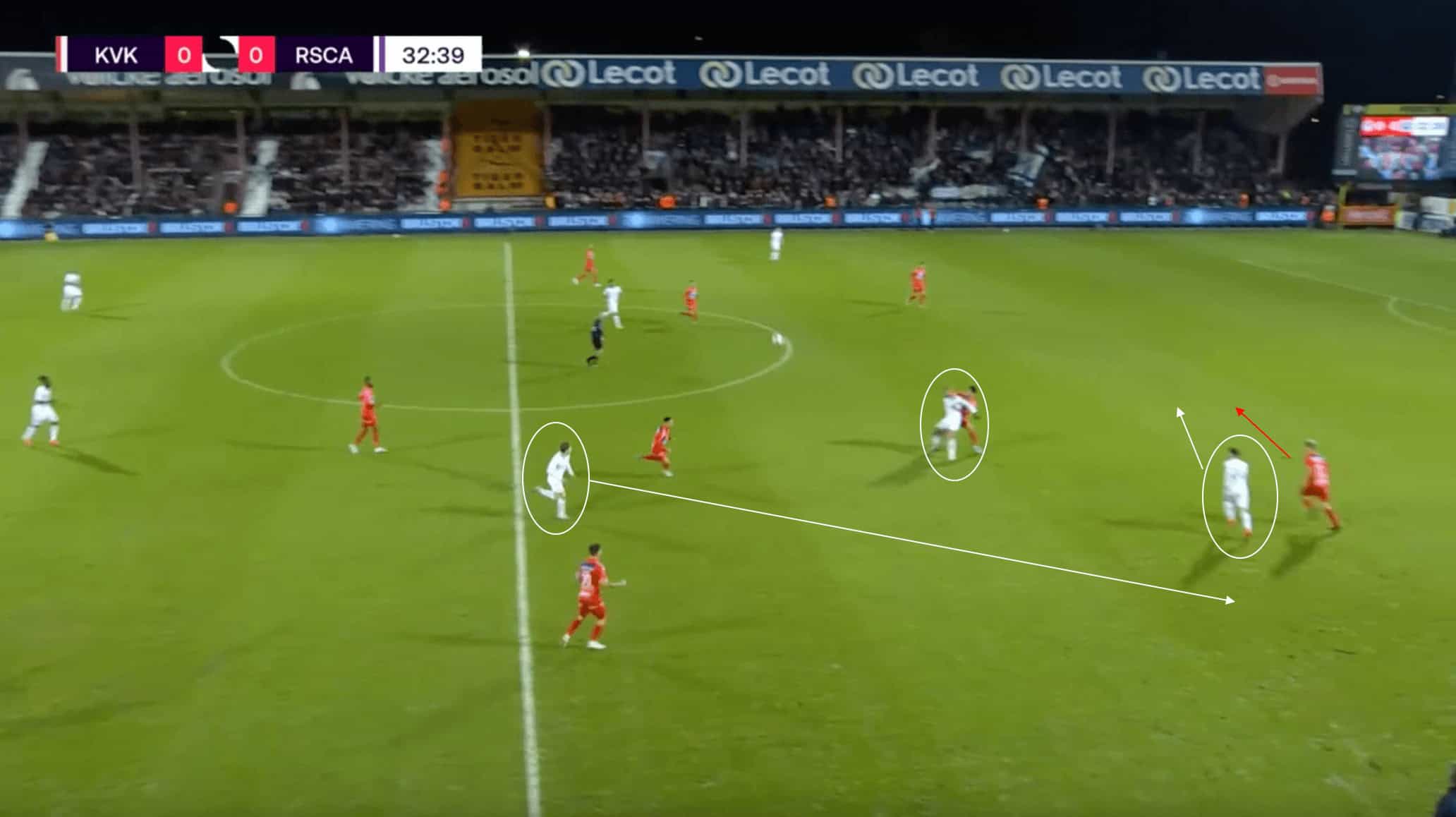
The image above shows another example of Anderlecht’s attacking rotations, this time originating from a ball played long by the goalkeeper.
The ball is played long to the forward, who drops into midfield, bringing the opposition central defender with him.
This opens up a gap in the Kortrijk defence, with the Anderlecht winger moving centrally into this vacant centre-forward role.
This movement inside attracts the fullback, who follows him to eliminate the option and close the space that has opened up centrally.
As a result of these two off-the-ball movements, the deeper-lying midfielder makes an in-to-out run from deep, moving into this wide space left vacant by the Kortrijk fullback.
Islam Slimani attempts to flick the ball into the path of the outside runner but, unfortunately, does not complete the attempt.
Nothing results from this attacking sequence from Anderlecht, but it again emphasises the way that Riemer is trying to get his side to create space in the opposition’s half spaces.
These rotations aim to drag players out of their zones and create openings for the ball to be played.
The final example above paints the same picture, with these attacking rotations in the wide channels looking to create space for Anderlecht to progress the ball vertically and break through the opposition’s defensive line.
In this attacking phase of play above, the ball is played wide from the centre-back to the winger, who has dropped deeper into midfield to receive in the half-space, as well as attract the attention of the Standard Liege fullback.
This again opens up the space behind the Standard defensive line for the deeper-lying midfield player to run into, which is being vacated by the fullback, who has been dragged out of his defensive zone.
Unfortunately, the ball is not quickly played into this space, with the chance going a-begging.
However, as this image and the previous one have shown, these attacking rotations work to create space for the ball to be played behind the opposition. At times, the issue just comes down to executing these opportunities.
Success at winning the ball back in advanced areas
The next thing that this tactical analysis will look at from Brian Riemer’s time in charge of Anderlecht so far is the success they have had at winning the ball back in advanced areas of the pitch.
In fact, since his appointment, the club has had the highest regains of any side in the Belgian Pro League, as the data visualization graphic below shows.
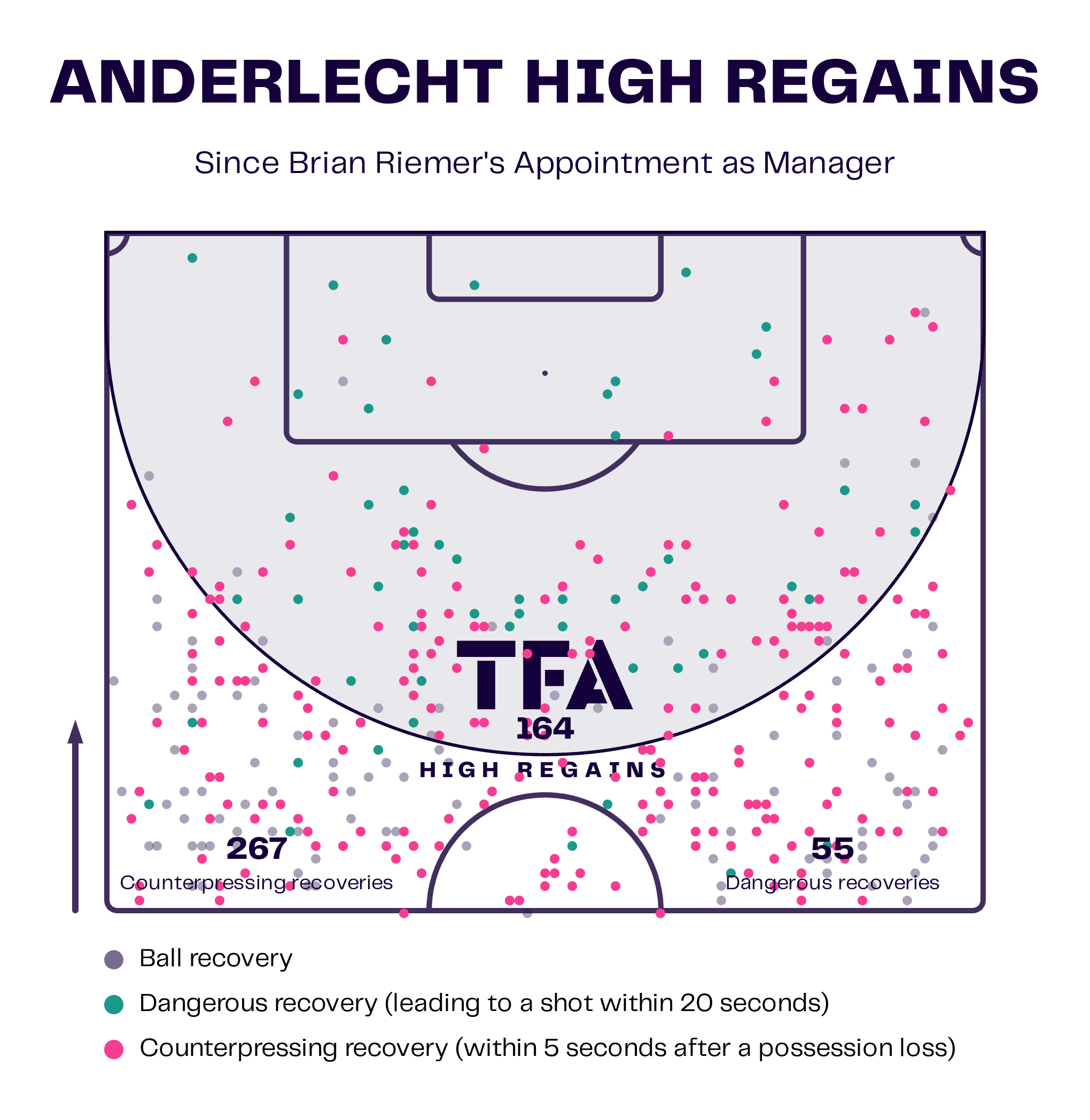
Since Brian Riemer’s appointment as manager, Anderlecht has had 164 high regains, the most in the Belgian Pro League in that time period (beginning of December).
This illustrates the numbers that the Belgian side looks to get around the ball in the attacking third of the pitch, with them looking to pressure the opposition players in possession and win the ball back in these advanced areas.
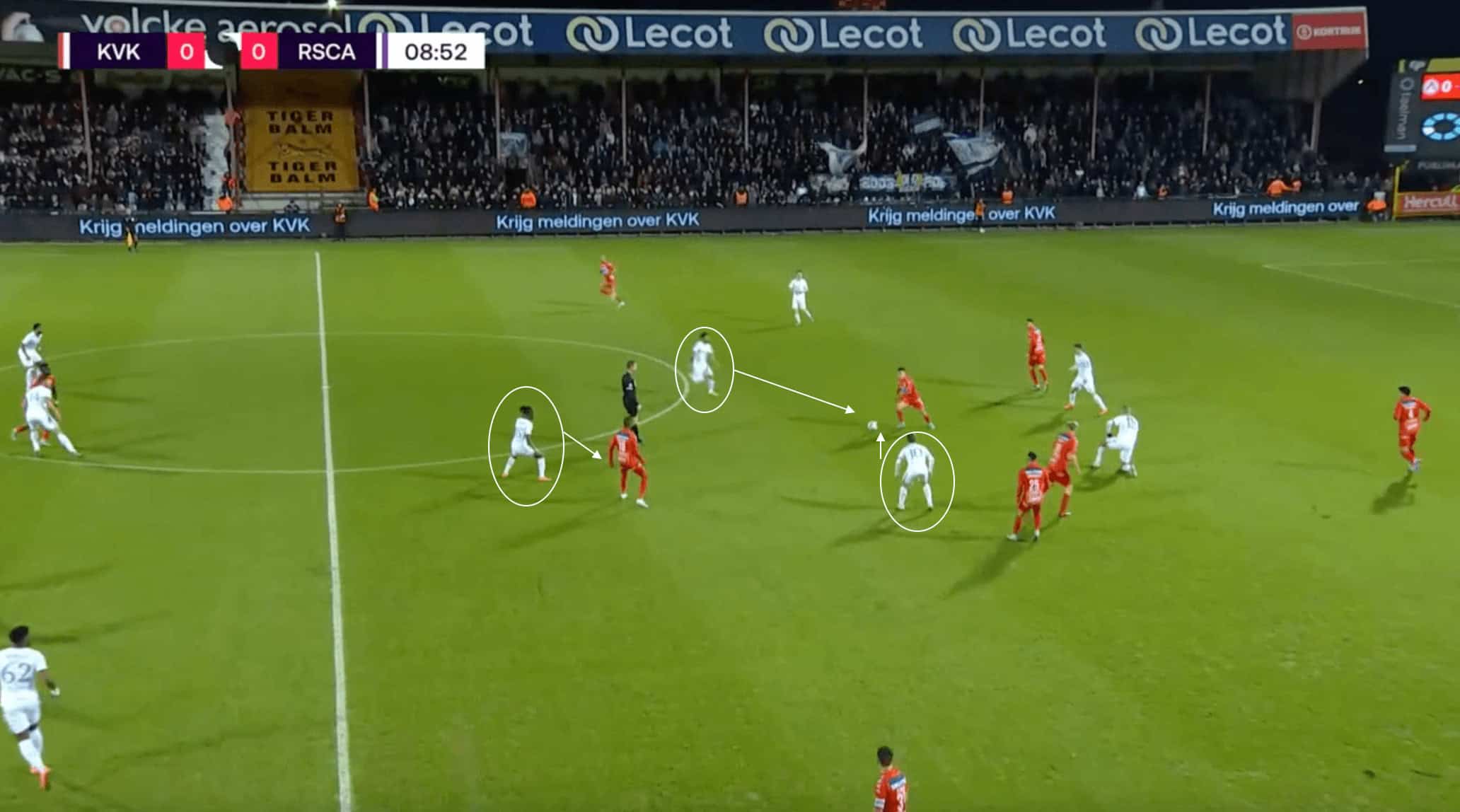
The image above shows a good example of what Anderlecht look to do when they lose possession in an advanced area of the pitch.
While they do not always look to counter-press, they are, as mentioned, the side with the highest number of high regains since Brian Riemer’s appointment.
This goes down to them strategically picking the best times to attempt to win back the ball in the advanced areas quickly, with them not looking to just counter-press aimlessly.
In the phase of play above, Anderlecht loses possession, and the Kortrijk player in possession looks to gather his composure before playing a pass.
This slight hesitation by the opposition player is the cue for the Anderlecht players to close down and engage, which they do.
Two Anderlecht players immediately close down the player in possession, and the closest free player is also vertically marked.
Unfortunately for the Belgian giants in this phase of play, the ball was switched out wide, with Kortrijk able to escape Anderlecht’s high regain opportunity.
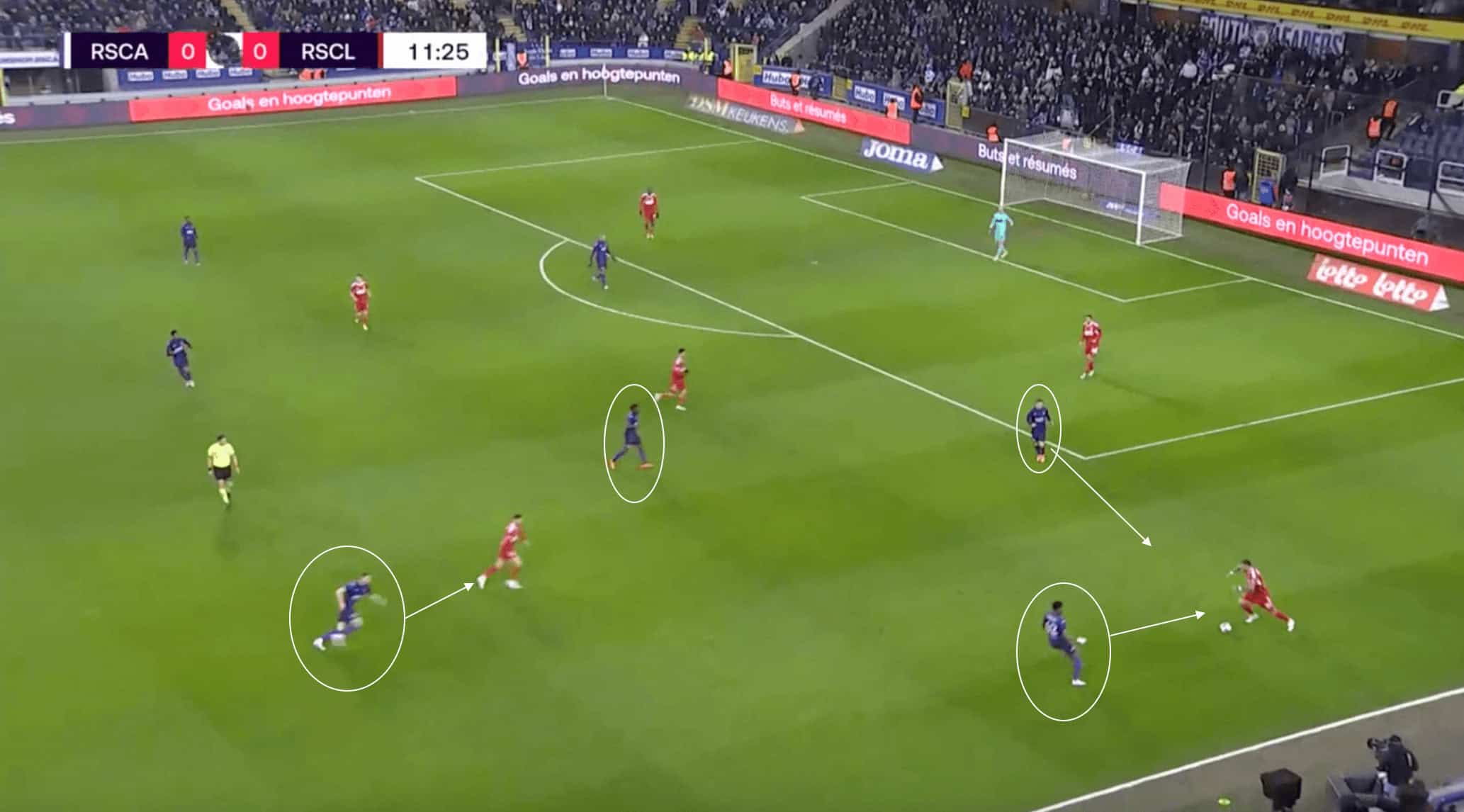
The image above shows another example of Anderlecht’s ability to do well when it comes to strategically picking their moments to press and look to gain possession of the ball high up the field.
As we can see from this pressing phase, the press is activated once the ball is played to one side.
This is the cue for the Anderlecht attackers to shift to this side and lock the ball into the near-side touchline.
The Belgian side also has a numerical advantage against the Standard players, as it is a 4v3 in this area of the pitch.
The ball gets pinned to one side, with the Anderlecht players looking to regain possession in this advanced area.
However, the press is once again broken by the opposition, with them able to escape and continue to build.
This ability to win the ball back in advanced areas has proved fruitful for the Belgian side this season.
While these examples have not shown success, they show exactly what the Danish manager has been able to implement on this side of the ball during his tenure so far.
Conclusion
Since Anderlecht appointed Brian Riemer, the side’s form has drastically improved. They moved up from close to the relegation zone to just on the edge of the European playoff places.
Tough times are still ahead for the Dane, however, with the club still fighting to climb up the table in Belgium. A round-of-16 matchup against Villarreal in the Europa Conference League is on the horizon, with the Spanish side already beating Real Madrid this season and running Barcelona close.
However, as this tactical analysis has shown, the future does look bright for Anderlecht under Brian Riemer’s style of play.





Comments